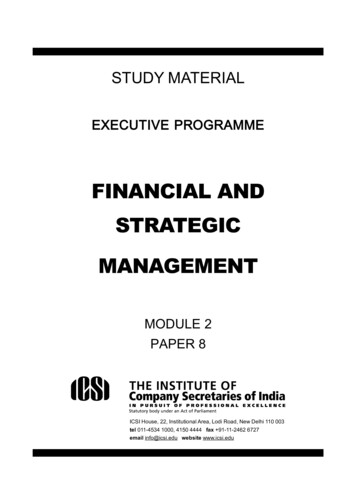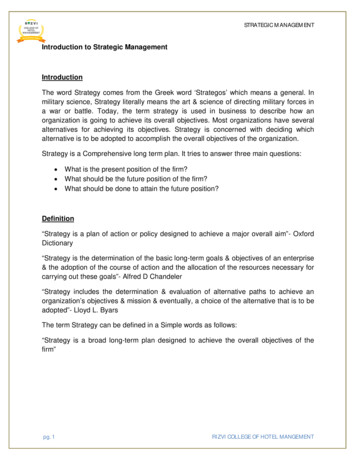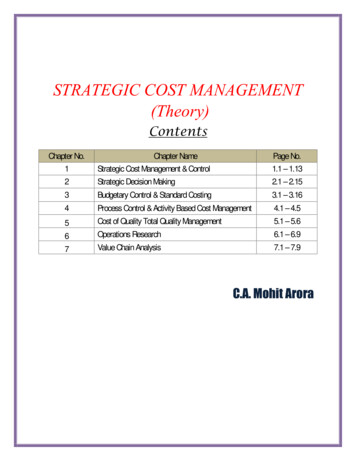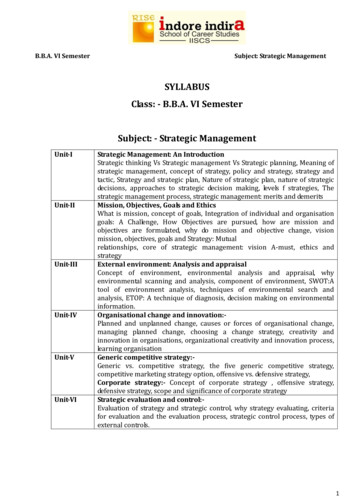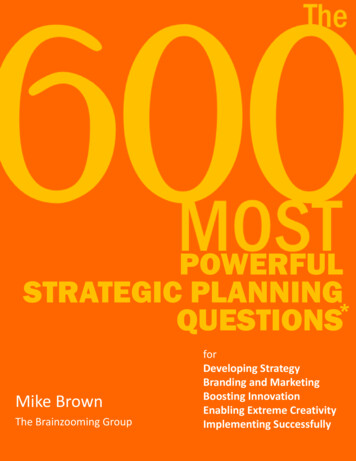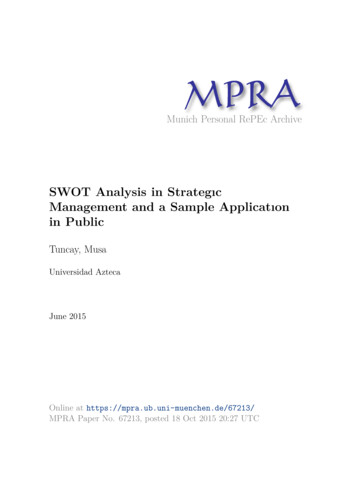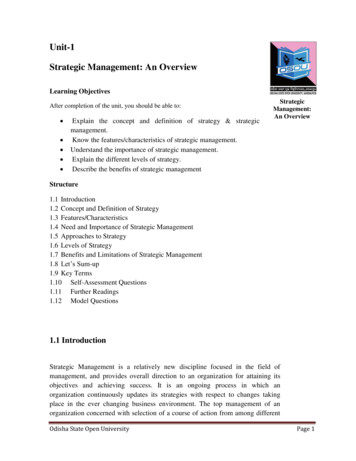
Transcription
Unit-1Strategic Management: An OverviewLearning ObjectivesAfter completion of the unit, you should be able to: Explain the concept and definition of strategy & strategicmanagement.Know the features/characteristics of strategic management.Understand the importance of strategic management.Explain the different levels of strategy.Describe the benefits of strategic managementStrategicManagement:An OverviewStructure1.1 Introduction1.2 Concept and Definition of Strategy1.3 Features/Characteristics1.4 Need and Importance of Strategic Management1.5 Approaches to Strategy1.6 Levels of Strategy1.7 Benefits and Limitations of Strategic Management1.8 Let‘s Sum-up1.9 Key Terms1.10 Self-Assessment Questions1.11 Further Readings1.12 Model Questions1.1 IntroductionStrategic Management is a relatively new discipline focused in the field ofmanagement, and provides overall direction to an organization for attaining itsobjectives and achieving success. It is an ongoing process in which anorganization continuously updates its strategies with respect to changes takingplace in the ever changing business environment. The top management of anorganization concerned with selection of a course of action from among differentOdisha State Open UniversityPage 1
alternatives to meet the organizational objectives. The process by whichobjectives are formulated and achieved is known as strategicmanagement andstrategy acts as the means to achieve the objective. Strategy is the grand design oran overall 'plan' which an organization chooses in order to move or react towardsthe set objectives by using its resources. Strategies most often devote a generalprogramme of action and an implied deployment of emphasis and resources toattain comprehensive objectives. An organization is considered efficient andoperationally effective if it is characterized by coordination between objectivesand strategies. There has to be integration of the parts into a complete structure.Strategy helps the organization to meet its uncertain situations with due diligence.Without a strategy, the organization is like a ship without rudder. It is like atramp, which has no particular destination to go to. Without an appropriatestrategy effectively implemented, the future is always dark and hence, more arethe chances of business failure.StrategicManagement:An Overview1.2 Concept and Definition of StrategyConcept of StrategyThe word ‗strategy'has entered in the field of management from the militaryservices where it refers to apply the forces against an enemy to win a war.Originally, the word strategy has been derived from Greek 'strategos' which meansGeneralship. The word was used for the first time in around 400 BC. The wordstrategy means the art of the general to fight in war.This connotes the art andscience of directing military forces. The strategy, according to a survey conductedin 1974 which asked corporate planners to define what they meant by strategy,―includes the determination and evaluation of alternative paths to an alreadyestablished mission or objective and eventually, choice of the alternative to beadopted.‘‘ Simply put, a strategy outlines how management plans to achieve itsobjectives. Strategy is the product of the strategic management process. Generally,when we talk of organisational strategy, it refers to organisation‘s top levelstrategy. However, strategies exist at other levels also. Chandler made acomprehensive analysis of interrelationships among environment, strategy, andorganisational structure. He analysed the history of organisational change in 70manufacturing firms in the US. While doing so, Chandler defined strategy as:―The determination of the basic long-term goals and objectives of an enterpriseand the adoption of the courses of action and the allocation of resources necessaryfor carrying out these goals‖. Chandler refers to three aspects: l Determination ofbasic long-term goals and objectives. l adoption of courses of action to achieveOdisha State Open UniversityPage 2
these objectives, and l allocation of resources necessary for adopting the coursesof action.The dictionary meaning of strategy is, "the art of so moving or disposing theinstrument of warfare as to impose upon enemy, the place time and conditions forfighting by one self."Strategic Management is all about identification and description of the strategiesthat managers can carry so as to achieve better performance and a competitiveadvantage for their organization. An organization is said to have competitiveadvantage if its profitability is higher than the average profitability for allcompanies in its industry.StrategicManagement:An OverviewDefinitionsIn management, the concept of strategy is taken in broader terms.Igor Ansoff (Father of Strategic Management) viewed that in developing strategy,it was essential to systematically anticipate future environmental challenges to anorganization, and draw up appropriate strategic plans for responding to thesechallenges.―Strategy is organisation‘s pattern of response to its environment over a period oftime to achieve its goals and mission.‖In 1960‘s, Chandler defines strategy as ―the determination of basic long-termgoals and objectives of an enterprise and the adoption of the course of action andthe allocation of resources necessary for carrying out these goals‖According to Glueck, "Strategy is the unified, comprehensive and integrated planthat relates the strategic advantage of the firm to the challenges of theenvironment and is designed to ensure that basic objectives of the enterprise areachieved through proper implementation process."The analysis of the above definition describes the following: Unified comprehensive and integrated plan.Strategic advantage related to challenges of environment.Proper implementation ensuring achievement of basic objectives.Michael porter defines strategy as ―creation of a unique and valuedposition involving a different activity from rivals or performs similaractivities in different ways.‖Odisha State Open UniversityPage 3
Michael Porter defines strategy as ―creation of a unique and valued positioninvolving a different activity from rivals or performs similar activities in differentways.‖1.3 Features/CharacteristicsStrategic Management as a distinct field of study has the following features orcharacteristics:StrategicManagement:An Overviewa. Strategy is Significant because it is not possible to foresee the futurewithout a perfect foresight; the firms must be ready to deal with theuncertain events which constitute the business environment. Therefore wecan say that strategy is future oriented.b. Strategy deals with long term developments rather than routine operations,i.e. it deals with probability of innovations or new products, new methodsof productions, or new markets to be developed in future.c. Strategy is created to take into account the probable behaviour ofcustomers and competitors. Strategies dealing with employees will predictthe employee behaviour.d. Strategy is a blend of internal and external factors of the organization i.e.(SWOT) analysis of the organization.e. Strategy provides overall framework for guiding organizational thinkingand action.1.4 Need and Importance of StrategyPlanning or designing a strategy involves a great deal of risk and resourceassessment, ways to counter the risks, and effective utilization of resources allwhile trying to achieve a significant purpose.An organization is generally established with a goal in mind, and this goal definesthe purpose for its existence. All of the work carried out by the organizationrevolves around this particular goal, and it has to align its internal resources andexternal environment in a way that the goal is achieved in rational expected time.Odisha State Open UniversityPage 4
Undoubtedly, since an organization is a big entity with probably a hugeunderlying investment, strategizing becomes a necessary factor for successfulworking internally, as well as to get feasible returns on the expended money.Strategic Management on a corporate level normally incorporates preparation forfuture opportunities, risks and market trends. This makes way for the firms toanalyze, examine and execute administration in a manner that is most likely toachieve the set aims. As such, strategizing or planning must be covered as thedeciding administration factor.StrategicManagement:An OverviewStrategic Management and the role it plays in the accomplishments of firms hasbeen a subject of thorough research and study for an extensive period of time now.Strategic Management in an organization ensures that goals are set, primary issuesare outlined, time and resources are pivoted, functioning is consolidated, internalenvironment is set towards achieving the objectives, consequences and results areconcurred upon, and the organization remains flexible towards any externalchanges.As more and more organizations have started to realize that strategic planning isthe fundamental aspect in successfully assisting them through any suddencontingencies, either internally or externally, they have started to absorb strategymanagement starting from the most basic administration levels. In actuality,strategy management is the essence of an absolute administration plan. For largeorganizations, with a complex organizational structure and extreme regimentation,strategizing is embedded at every tier.Apart from faster and effective decision making, pursuing opportunities anddirecting work, strategic management assists with cutting back costs, employeemotivation and gratification, counteracting threats or better, converting thesethreats into opportunities, predicting probable market trends, and improvingoverall performance.Keeping in mind the long-term benefits to organizations, strategic planning drivesthem to focus on the internal environment, through encouraging and settingchallenges for employees, helping them achieve personal as well as organizationalobjectives. At the same time, it is also ensured that external challenges are takencare of, adverse situations are tackled and threats are analyzed to turn them intoprobable opportunities.Odisha State Open UniversityPage 5
1.5 Approaches to StrategyThese different positions on corporate strategy are reflected in its history. Afterthe Second World War, many concepts about strategy were translated from themilitary into the corporate world. In the 1960s, strategy meant complex anddetailed planning based on economic models and detailed forecasts. Thecredibility of this approach was undermined in the following decades as a result ofthe impact of significant oil price rises (meaning the assumptions underlying theplans had to be revised). There was also the success of many Japanese companies,for whom detailed planning was apparently less of a priority. One of Mintzberg'searlier contributions to the field was to categorise different approaches to strategymaking. In 1973, he suggested these were:StrategicManagement:An Overview The adaptive The entrepreneurial Planning.Another influential theorist was Michael Porter, who invigorated the field in 1980by arguing that corporate strategy should be based on the conditions of theindustry, and the company's relative position in that industry. Organisationsshould identify their strengths (or 'core competencies') and concentrate on ordiscover markets where those skills could be exploited. The concept of corecompetencies was relevant for both organic and acquisitive growth, informeddiversification and divestment strategies. Porter's focus was on the interfacebetween the organisation and its environment. Competencies Theory wasdeveloped into a more 'inside out' focus when Gary Hamel and C. K. Prahaladpublished their core competencies model in 1990. They took as the starting pointfor strategy development the core strengths of the organisation, and advised that acore competence was recognised by: providing potential access to a wide variety of markets making a significant contribution to the benefits of a product as perceived bycustomers being hard to replicate by competitors. Management‘s role was to create theenvironment to facilitate the creation of these core competencies.The competencies themselves were intended to equip entities to adapt quickly tochanging environments and to produce innovative, even unexpected, products.Odisha State Open UniversityPage 6
Around the same time, Jack Welch (whose perspectives still influence manybusiness leaders) disbanded his company‘s planning department of about 200 staffat General Electric in the USA. He argued that the planners were divorced fromthe front-line, and were too concerned with planning in detail and not enough oncompetitive positioning and identification of potential markets. Welch devolvedresponsibility for strategic planning to the heads of GEC‘s 12 business units,expecting them to be more responsive to change.StrategicManagement:An OverviewEvery organization needs a strategy and there are generally the followingthree approaches to forming this strategy.Internally-Driven OrganizationsMost organizations are internally driven, which means that their strategy is drivenby what they have done in the past; their thinking is inside out. The weakness withthis strategy is that organization members are not anticipating changes that arehappening in the marketplace.Customer-Driven OrganizationsCustomer-driven organizations are those who try to by close and ready to listen tothe customer. The problem with approach is that these organizations end up tryingto be ―all things to all people.‖Market-Driven OrganizationsLastly, Market-driven organizations base their strategy on making consciouschoices about which markets they will serve and how they will add value. Highperformance organizations not only participate in the strategy process, they alsounderstand which strategy will propel their organizations forward.1.6 Levels of StrategyLevels of Strategic ManagementIt is believed that strategic decision making is the responsibility of topmanagement. However, it is considered useful to distinguish between the levels ofoperation of the strategy. . Typically, three broad levels can be identified asillustrated in Figure 1.1.Odisha State Open UniversityPage 7
StrategicManagement:An Overview Corporate LevelBusiness LevelFunctional LevelThere are basically two categories of companies- one, which have differentbusinesses organized as different directions or product groups known as profitcentres or strategic business units (SBUs) and other, which consists of companieswhich are single product companies. The example of first category can be that ofReliance Industries Limited which is a highly integrated company producingtextiles, yarn, and a variety of petro chemical products and the example of thesecond category could be Ashok Leyland Limited which is engaged in themanufacturing and selling of heavy commercial vehicles. The SBU concept wasintroduced by General Electric Company (GEC) of USA to manage productbusiness. The fundamental concept in the SBU is the identification of discreteindependent product/ market segments served by the organization. Because of thedifferent environments served by each product, a SBU is created for eachindependent product/ segment. Each and every SBU is different from anotherSBU due to the distinct business areas (DBAs) it is serving. Each SBU has aOdisha State Open UniversityPage 8
clearly defined product market segment and strategy. It develops its strategyaccording to its own capabilities and needs with overall organizations capabilitiesand needs. Each SBU allocates resources according to its individual requirementsfor the achievement of organizational objectives. As against the multi productorganizations, the single product organizations have single Strategic BusinessUnit. In these organizations, corporate level strategy serves the whole business.The strategy is implanted at the next lower level by functional strategies. Inmultiple product company, a strategy is formulated for each SBU (known asbusiness level strategy) and such strategies lie between corporate and functionallevel strategies.StrategicManagement:An OverviewThe three levels are explained as follows:Corporate Level StrategyAt the corporate level, strategies are formulated according to organization wisepolices. These are value oriented, conceptual and less concrete than decisions atthe other two levels. These are characterized by greater risk, cost and profitpotential as well as flexibility. Mostly, corporate level strategies are futuristic,innovative and pervasive in nature. They occupy the highest level of strategicdecision making and cover the actions dealing with the objectives of theorganization. Such decisions are made by top management of the firm. Theexample of such strategies includes acquisition decisions, diversification,structural redesigning etc. The board of Directors and the Chief Executive Officerare the primary groups involved in this level ofstrategy making. In small andfamily owned businesses, the entrepreneur is both the general manager and chiefstrategic manager.Business Level StrategyThe strategies formulated by each SBU to make best use of its resources given theenvironment it faces, come under the account of business level strategies. At sucha level, strategy is a comprehensive plan providing objectives for SBUs, allocationof resources among functional areas and coordination between them forachievement of corporate level objectives. These strategies operate within theoverall organizational strategies i.e. within the broad constraints and polices andlong term objectives set by the corporate strategy. The SBU managers areinvolved in this level of strategy. The strategies are related with a unit within theorganization. The SBU operates within the defined scope of operations by thecorporate level strategy and is limited by the assignment of resources by thecorporate level. However, corporate strategy is not the sum total of businessstrategies of the organization. Business strategy relates with the "how" and thecorporate strategy relates with the "what"' Business strategy defines the choice ofOdisha State Open UniversityPage 9
product or service and market of individual business within the firm. Thecorporate strategy has impact on business strategy.Functional Level StrategyThis strategy relates to a single functional operation and the activities involvedtherein. This level is at the operating end of the organization. The decisions at thislevel within the organization are described as tactical. The strategies areconcerned with how different functions of the enterprise like marketing, finance,manufacturing etc. contribute to the strategy of other levels. Functional strategydeals with a relatively restricted plan providing objectives for specific function,allocation of resources among different operations within the functional area andcoordination between them for achievement of SBU and corporate levelobjectives.StrategicManagement:An OverviewSometimes a fourth level of strategy also exists. This level is known as theoperating level. It comes below the functional level strategy and involves actionsrelating to various sub functions of the major function. For example, thefunctional level strategy of marketing function is divided into operating levelssuch as marketing research, sales promotion etc.Three levels of strategies have different characteristics as shown in the significantLowLowLowLowSignificant1.7 Benefits and Limitations of Strategic ManagementThere are many benefits of strategic management and they include identification,prioritization, and exploration of opportunities. For instance, newer products,newer markets, and newer forays into business lines are only possible if firmsindulge in strategic planning. Next, strategic management allows firms to take anOdisha State Open UniversityPage 10
objective view of the activities being done by it and do a cost benefit analysis asto whether the firm is profitable.Just to differentiate, by this, we do not mean the financial benefits alone (whichwould be discussed below) but also the assessment of profitability that has to dowith evaluating whether the business is strategically aligned to its goals andpriorities.The key point to be noted here is that strategic management allows a firm to orientitself to its market and consumers and ensure that it is actualizing the rightstrategy.StrategicManagement:An OverviewFinancial BenefitsIt has been shown in many studies that firms that engage in strategic managementare more profitable and successful than those that do not have the benefit ofstrategic planning and strategic management.When firms engage in forward looking planning and careful evaluation of theirpriorities, they have control over the future, which is necessary in the fastchanging business landscape of the 21st century.It has been estimated that more than 100,000 businesses fail in the US every yearand most of these failures are to do with a lack of strategic focus and strategicdirection. Further, high performing firms tend to make more informed decisionsbecause they have considered both the short term and long-term consequences andhence, have oriented their strategies accordingly. In contrast, firms that do notengage themselves in meaningful strategic planning are often bogged down byinternal problems and lack of focus that leads to failure.Non-Financial BenefitsThe section above discussed some of the tangible benefits of strategicmanagement. Apart from these benefits, firms that engage in strategicmanagement are more aware of the external threats, an improved understanding ofcompetitor strengths and weaknesses and increased employee productivity. Theyalso have lesser resistance to change and a clear understanding of the link betweenperformance and rewards.The key aspect of strategic management is that the problem solving and problempreventing capabilities of the firms are enhanced through strategic management.Strategic management is essential as it helps firms to rationalize change andactualize change and communicate the need to change better to its employees.Finally, strategic management helps in bringing order and discipline to theactivities of the firm in its both internal processes and external activities.Odisha State Open UniversityPage 11
Wheelen, Hunger and Rangarajan stated 3 most highly rated benefits ofStrategic Management to be: Clear sense of Strategic vision for the firm. Sharper focus on what is strategically important Improved understanding of a rapidly Changing environmentAccording to Greenley, strategic management has following benefits: It allocates for identification, prioritization, and exploitation ofopportunities.It provides an objective outlook of management problems.It characterizes a framework for improved synchronization and controlof activities.It reduces the effects of adverse conditions and changes.It allows major decisions to better support established objectives.It allows more effective distribution of time and resources to identifiedopportunities.It permits fewer resources and less time to be devoted to correctingerroneous or ad hoc decisions.It generates a framework for internal communication among personnel.It helps integrate the behaviour of individuals into a total effort.It provides a foundation to clarify individual responsibilities.It promotes forward thinking.It provides a cooperative, integrated, and enthusiastic approach totackling problems and opportunities.It encourages a positive attitude toward change.It gives a degree of discipline and formality to the management of abusiness.StrategicManagement:An OverviewLimitationsBesides numerous benefits, Strategic Management has following disadvantages:Strategic Management is based on certain principles and if the properties do nothold suitable the strategy or plans based on them would not be sensible oreffectual. SWOT analysis is an important exercise in Strategic Management whichrequires lot of action and information. When these two are lacking the usefulnessof the SWOT analysis is questionable and it could even lead to formulation ofwrong or effective strategies. In Strategic Management, effective implementationis essential that demands many factors such as resource allocation, leadershipimplementation, right structure and effective evaluation andcontrol. The cause forthe failure of many strategies is the implementation failure. Company may faceOdisha State Open UniversityPage 12
serious issues if there is lack of involvement of the internal people in the strategyformulation and when they are not equally taken into confidence. StrategicPlanning is a multifaceted and complex task which requires people with vision,expertise and commitment and an appropriate system. Strategic Management is anexpensive process. Major drawback of Strategic Management is that it sometimesmakes the organization over determined and resultant failure to reach the goalscause disturbance. Impractical strategies may lead to serious problems.The important limitations of Strategic management are the following:StrategicManagement:An Overview SM is based on certain premises and if the premises do not hold valid thestrategy or plans based on them would not be realistic or effective. SWOT analysis is an important exercise in SM, which requires lot of exerciseand information. When these two are lacking the utility of the SWOT analysis isquestionable and it could even lead to formulation of wrong or effective strategies. In SM effective implementation is vital that demands many things – resourceallocation, leadership implementation, right structure and effective evaluation andcontrol. The reason for the failure of many strategies is the implementationfailure. A serious problem generally rising in a company if there is lack of involvementof the internal people in the strategy formulation and when they are not equallytaken into confidence. Strategic Planning is a complex and difficult task which requires people withvision, expertise and commitment and an appropriate system SM is a costly exercise One of the most important criticisms against Strategic Management is that itsometimes makes the organization over ambitious and resultant failure to reachthe goals cause frustration. Unrealistic strategies may land companies in severeproblems.1.8 Let’s Sum-upStrategic management facilitate an organization to make its decisions based onlong-term prediction. It also allows the establishment to make action at an earlystage of new trend and consider the lead-time for effective management. Thestudy of strategic management stresses the monitoring and evaluating of externalopportunities and threats in the view of a company's strengths and weaknesses inorder to create and implement innovative strategic direction for company.Odisha State Open UniversityPage 13
Strategy is the complex process of determining the action that need to be carriedout in order to achieve the organization‘s purpose. It is focused on the mediumand long term future perspective rather that the current operations. Strategy is amajor course of action, a blend of internal and external factors and is particular toa specific situation. It is dependent on external variables and is futuristic in nature.In recent years, virtually all firms have realized the importance of strategicmanagement. However, the key difference between those who succeed and thosewho fail is that the way in which strategic management is done and strategicplanning is carried out makes the difference between success and failure. Ofcourse, there are still firms that do not engage in strategic planning or where theplanners do not receive the support from management. These firms ought torealize the benefits of strategic management and ensure their longer-term viabilityand success in the marketplace.StrategicManagement:An Overview1.9 Key TermsStrategy: A unified, comprehensive and integrated plan that relates the strategic advantageof the firm to the challenges of the environment.Strategic management: It is a set of managerial decisions and action that determine the longterm performance of a company.Levels of Strategy: There are different levels of strategic decision making and strategicmanagement in the organization i.e. corporate-level strategy, business- level strategies andfunctional level strategy.Strategists: There are individuals or groups who are primarily involved in the formulation,implementation and evolution of the strategy. They perform key activities related to variousaspects of strategic management.1.10 Self-Assessment Questions1. What do you mean by strategy? Explain the nature of strategy.2. What is the importance of strategy? Illustrate your answer with suitable examples.3. Explain the various levels at which a strategy may be implemented in an organization.Odisha State Open UniversityPage 14
1.11 Further Readings1. Michael Hitt, R. Duane Ireland, Robert E. Hoskisson, ―StrategicManagement Competitiveness & Globalisation‖, South -Western ThomsonLearning.2. Kazmi, Azhar, ―Business Policy and Strategic management‖, Tata McgrawHill Publishing Co, Ltd., New DelhiStrategicManagement:An Overview3. Mamoria, C.B., Mamoria, Satish and Rao, P. Subba,. ―Business Planningand Policy‘, Himalaya Publishing House, Mumbai.4. Srinivasan R, ―Strategic Management the Indian Context‖ (2014). Fifthedition, PHI Learning Private Limited, New Delhi.1.12 Model Question1. Explain the benefits and limitations of strategic management.2. Critically examine the different approaches to strategyOdisha State Open UniversityPage 15
UNIT-2Vision, Mission,Objectives and GoalsLearning ObjectivesAft
Describe the benefits of strategic management Structure 1.1 Introduction 1.2 Concept and Definition of Strategy 1.3 Features/Characteristics 1.4 Need and Importance of Strategic Management 1.5 Approaches to Strategy 1.6 Levels of Strategy 1.7 Benefits and Limitations of Str




